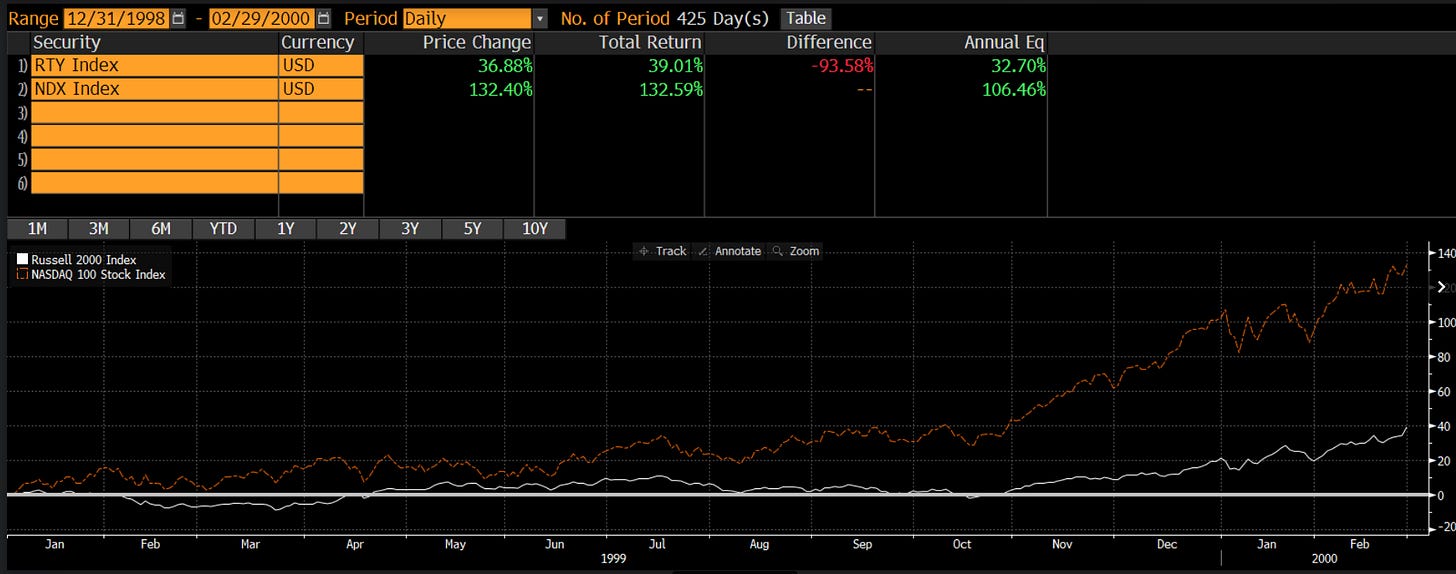Making Hay (Almost) Monday - February 20th, 2024
High-level macro-market insights, actionable economic forecasts, and plenty of friendly candor to give you a fighting chance in the day's financial fray.
“It has been said that history repeats itself. This is perhaps not quite correct; it merely rhymes.” -Theodor Reik (words to that effect are often mistakenly believed to have been spoken by Mark Twain — Our thanks to Quote Investigator)
Rhyme Time
Please humor me for a few moments while I highlight some eerie parallels. Perhaps I’ve missed them, but I haven’t seen anyone pointing out the number of similarities with current market behavior and what was seen almost exactly 24 years ago.
It was the late winter of 2000 when the tech-heavy NASDAQ was soaring to previously unimagined heights. This was after a run-up in the late 1990s that was even more feverish than what had held the prior record for American speculative excess: the end of the Roaring ‘20s.
Naturally, this isn’t like an AI-generated replica of what happened at the start of the 21st Century. There are, for sure, glaring differences, particularly when it comes to U.S. government finances. In those days, which now seem like several lifetimes ago, the then-Fed head Alan Greenspan was publicly agonizing that there would be no Treasury bond market by 2010. This was because the federal government was running large surpluses which Mr. Greenspan anticipated would continue indefinitely. In his estimation, it might only take a decade to retire all outstanding federal debt.
While he conveniently ignored the issue of trillions of unfunded entitlements, the fact of the matter is that U.S. Treasury bonds were the safest fixed-income instruments on the planet at that time. As we all sadly know, that situation has done a complete 180°.
Regarding the rhymes with February 2000, let’s consider what the Fed has been doing in recent years. As was the case back then, it has completed a long rate hiking campaign. Reflecting that, bond yields have risen significantly, as they also did at the end of the last century. Interestingly, they also fell sharply at the start of 2000, from 6¾% to around 5½% by the end of March of 2000. Undoubtedly, that helped provide the impetus for the final speculative blow-off top, arguably the most extreme in all of market history — at least until 2021. That bond rally was similar to what happened since last October when the 10-year T-note yield plunged from over 5% to around 3.8% in December.
Another rerun is that U.S. Treasury (UST) yields have risen considerably since that 3.8% trough. They are now back in the 4.3% range. The same thing happened in early 2000 when the interest rate on USTs zoomed from 5½% to 6½% in very short order. That may well have been another pin that punctured the massive bubble of those days, along with such outrageous overvaluation that a crash had become inevitable. The NASDAQ would fall nearly 80% by the time it hit bottom in 2002.
In addition to the fact that the late stage of the great tech mania was also led by a small number of stocks, there was another similarity related to this point. This was the comparative performance of the Russell 2000 (small cap) index versus the NASDAQ. As you can see below, the divergence between the two back then was enormous, as it is again today.
Russell 2000 vs. NASDAQ - Total returns from 12/31/1998 to 2/29/2000 - (Click chart to expand)
White Line: Russell 2000 | Orange Line: NASDAQ
Total returns from 12/30/2022 Through Present - (Click chart to expand)
White Line: Russell 2000 | Orange Line: NASDAQ
Subsequent to that, the reversal of fortune was equally dramatic. In fact, it would last for the next 14 years.
March 2000 NASDAQ Peak Through 3/15/14 - (Click chart to expand)
White Line: Russell 2000 | Orange Line: NASDAQ
What if by some strange coincidence, we are on the verge of seeing a similar performance inversion? If we are, you might want to be reorienting your portfolio, at least to a certain degree. In other words, it may be prudent to be cashing in some monster gains on tech stocks and redeploying some of the proceeds into shares with much less ebullient valuations. An example you might want to consider will be discussed in the section immediately following for paid subscribers. (Also for those who help support the Haymaker mission, we’ll be sending out a short video this week on a legendary portfolio manager who is doing exactly that.)
As will be described behind the paywall, it’s not just tech stocks that are trading at extremely generous P/E ratios. Even certain elite retailers are trading at valuations reminiscent of the early-2000 era. Back then, that was also the case with stocks like GE, Gillette, and Coca-Cola priced at 40-50 times earnings — before they, too, had their return-to-reality experience.





